Hidden heritage: Potential bison kill site under dog park in Pincher Creek

Meanwhile, as Green pointed out, the site’s historical context raises further questions about its precise usage: “It’s very possible that it’s an impound area. But the first archeologist could not decide whether one of the cliffs was involved in a jump. Unless we assess it and find lithic material, like stone tools and perhaps some arrowheads, we won’t know for sure.” A new examination The topic of DiP1-4’s significance resurfaced after two decades with a site visit conducted by Atlatl Archaeology in 2022. Their firm studied Dau’s report and emphasized that excavating identified locations would be beneficial, as they are situated on different terraces of the landform and may represent distinct activity areas. For instance, it was speculated that the area surrounding the northern end of the site was a possible pound and processing area, a theory that seems plausible given the frequency of identifiable and fragmented bone observed while walking the trails in that vicinity. In contrast, the southeastern portion of the site is located on the first terrace above the creek, where faunal remains were sparser. However, this area presents an ideal location for processing or use as a campsite due to its immediate access to water and shelter from the wind. In its report, Atlatl Archaeology advocated for further exploration of both areas to gain a better understanding of their historical significance, which would greatly enhance the interpretation of the site. A call for further exploration As the community enjoys the recreational benefits of DiP1-4, Coun. Green sees a pressing need to bridge the gap between its present use and its historical significance. His vision for the land includes a collaborative effort to engage local schools, Indigenous groups and historians in further studies to confirm its past and integrate that knowledge into educational programs. By uncovering the rich cultural heritage of DiP1-4, Pincher Creek could not only enhance its community identity but also promote a more profound understanding of Indigenous history. Recognizing the land’s significance as a potential Blackfoot bison kill site could transform a simple walking trail into a living classroom — a place where the community learns about the land’s history and the importance of reconciliation with Indigenous Peoples.
By Somya Lohia, Local Journalism Initiative Reporter
In the heart of Pincher Creek, a land parcel serves as a beloved community space featuring a picturesque walking trail and off-leash dog park where residents enjoy the tranquility of nature. However, beneath its surface lies a rich tapestry of history that remains largely unrecognized.
According to town councillor David Green, this land may have once served as a Blackfoot bison kill site, an essential site for Indigenous culture and livelihood that offers a unique opportunity for education and reconciliation within the community.
“Very few people understand what that piece of land is all about,” Green told Shootin’ the Breeze. “It’s a beautiful walking trail and it does get used by the community, but I think we’re missing a big educational opportunity here.”

Bone fragments from the DiP1-4 excavation site, provided by Pincher Creek town councillor David Green, hint that the area may have been a historic bison kill site.Somya Lohia

He emphasized that while teachers often take students there to learn about the environment — the water, trees, foliage and wildlife — there is little awareness of the land’s historical significance as a site for bison hunting practices.
Green believes that acknowledging this cultural heritage is a crucial step toward fostering understanding and reconciliation between communities.
“None to my knowledge have ever mentioned the fact that it was a Blackfoot bison kill site and that there is cultural material all over the place,” he said.
This missing piece of history, he argues, could enhance the educational experiences of local students and community members alike.
The land parcel, known as DiP1-4, was said to be a “multi-component bison kill/campsite” by Ethos Consultants Ltd. in the early 1990s.
However, the question of whether DiP1-4 was used as a kill site or as a bison jump site remains unanswered.
The archeological evidence
The possibility of the site being a bison kill or campsite first emerged after the Town of Pincher Creek contracted Ethos in July 1990 to undertake a historical resources investigation program on a series of small terraces located on the west side of Pincher Creek, where the town planned to expand its regional trail system.
After finding bison bones along the edges of the terraces, fieldwork was conducted in September 1990, involving shovel and backhoe tests. During this process, DiP1-4 was identified.
“This site is a multi-component buried camp/kill containing from one to five occupations buried to depths of 220 cm below surface,” Barry J. Dau, senior archeologist at Ethos, said in his report.
“While the amount of cultural material from each occupation was relatively limited, and no diagnostic items such as projectile points were recovered, the number of defined occupations and their depth indicate that the site could contain important cultural information.”

During the fieldwork, Dau collected 386 pieces of cultural material from the various tests, revealing the presence of a bison kill site.
Following this, Dau sent the bone samples for radiocarbon dating and the results, he said, were “surprising and interesting.”
A sample from one of the deepest occupations was dated to about 1040 AD.
“As it was one of the deepest occupations in the site, I expected a fairly old date. However, the sample returned an age of 910±70 years BP, Dau said.
“The term ‘BP’ refers to years Before Present, relative to 1950 AD. This date suggests that Occupation 4 from Backhoe Test 1 occurred around 1040 AD.”
Another sample indicated usage around 490±80 years BP, or about 1460 AD.
These dates suggest that DiP1-4 was utilized primarily during the Late Prehistoric Period, Dau said in the report.
He further suggested that the native occupants of the site were pedestrian hunters, well versed in the use of the bow and arrow.
However, the relatively young age of the lower bone beds suggests that the uppermost occupations may have occurred during the Protohistoric or Historic periods, when European trade goods, especially horses and guns, were introduced to southern Alberta.
The analysis from Ethos Consultants indicates that the native occupants of the site were adept at utilizing their environment for survival.
Meanwhile, as Green pointed out, the site’s historical context raises further questions about its precise usage: “It’s very possible that it’s an impound area. But the first archeologist could not decide whether one of the cliffs was involved in a jump. Unless we assess it and find lithic material, like stone tools and perhaps some arrowheads, we won’t know for sure.”
A new examination
The topic of DiP1-4’s significance resurfaced after two decades with a site visit conducted by Atlatl Archaeology in 2022.
Their firm studied Dau’s report and emphasized that excavating identified locations would be beneficial, as they are situated on different terraces of the landform and may represent distinct activity areas.
For instance, it was speculated that the area surrounding the northern end of the site was a possible pound and processing area, a theory that seems plausible given the frequency of identifiable and fragmented bone observed while walking the trails in that vicinity.
In contrast, the southeastern portion of the site is located on the first terrace above the creek, where faunal remains were sparser. However, this area presents an ideal location for processing or use as a campsite due to its immediate access to water and shelter from the wind.
In its report, Atlatl Archaeology advocated for further exploration of both areas to gain a better understanding of their historical significance, which would greatly enhance the interpretation of the site.
A call for further exploration
As the community enjoys the recreational benefits of DiP1-4, Coun. Green sees a pressing need to bridge the gap between its present use and its historical significance.
His vision for the land includes a collaborative effort to engage local schools, Indigenous groups and historians in further studies to confirm its past and integrate that knowledge into educational programs.
By uncovering the rich cultural heritage of DiP1-4, Pincher Creek could not only enhance its community identity but also promote a more profound understanding of Indigenous history.
Recognizing the land’s significance as a potential Blackfoot bison kill site could transform a simple walking trail into a living classroom — a place where the community learns about the land’s history and the importance of reconciliation with Indigenous Peoples.
